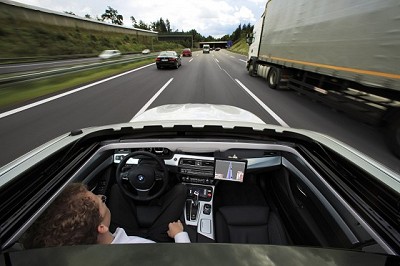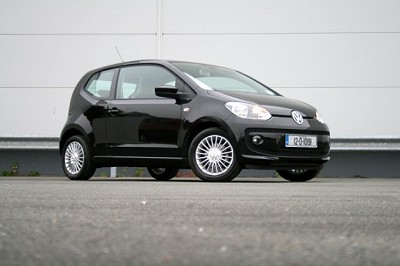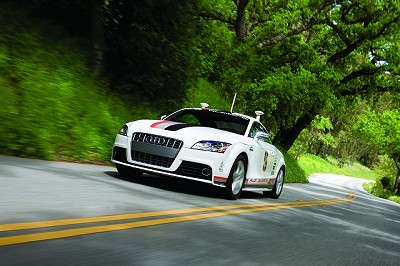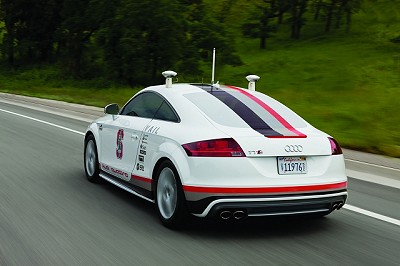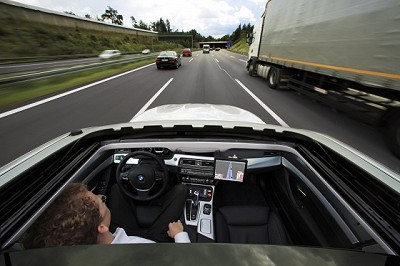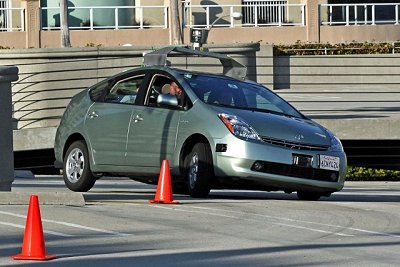Ever wondered why Google has invested so much time and money in its Street View technologies? Amazingly, the California-based company did not send a fleet of camera cars around the world so you could spy on your neighbour or search for those elusive oddities like alfresco fornication on a college campus. Instead, the technology forms the backbone of Google's driverless car software.
Unless you have been living under a stone recently the Google Cars (as they have become known) are big news and even bigger over the last day or two with the announcement that the state of Nevada has granted Google a licence to test its autonomous cars on the state's roads. The Google fleet includes a handful of Toyota Prius, a Lexus RX 450h and an Audi TT, all using video cameras, radar sensors and a laser range finder that allows the cars to "see" other traffic, along with an artificial intelligence system that, with the help of the Street View maps, allows the cars to navigate around the world.
Already the Google team reckons its cars have racked up over 225,000 kilometres between them with drives from the Google campus in Mountain View to its offices in Santa Monica. A trip over the Golden Gate Bridge, a leisurely drive along the Pacific Coast Highway and even a jaunt out to Lake Tahoe. The trip to Lake Tahoe alone is over 780 kilometres - or in Irish terms it is the same as driving from Dublin to Clifden, back to Dublin (presumably because you left the immersion on) and back to Clifden again, all with the car driving itself - leaving the occupants free to do... whatever it is we do when we are in a car but not driving.
All sounds a bit alien or futuristic doesn't it? Sitting in the 'driver's' seat of a car but ultimately handing control over to a bank of computers and some clever technology - and if you were to believe Hollywood it is futuristic. Movies such as Demolition Man, Minority Report and iRobot have all shown some sort of driverless cars that we may some day use to get from A to B.
But is the associated technology actually that futuristic?
On the face of it, yes - sure wouldn't we all have driverless cars if the technology was available today? But the truth is that the Google Cars are little more than a culmination of technologies that are currently seen on the roads in everything from the Volkswagen up! to the Mercedes-Benz S-Class.
The up!, Volkswagen's breakthrough city car, was recently awarded a full five-star Euro NCAP rating with a special mention for its Active City Brake system, which is fitted as standard across the range. A camera mounted above the rear-view mirror scans the road ahead and if it detects an impending collision - be it from the car in front coming to a halt or a pedestrian walking in front of your car - it will apply the brakes and stop the car for you.
Hardly self-driving now is it?
No you're right, so how about this - the latest models from Audi, BMW and Mercedes-Benz can be fitted with adaptive cruise control that locks on to the car in front of you via lasers and will accelerate or brake accordingly. Thankfully it's not limited to the car in front though; if someone cuts you up on the motorway it will detect them and react accordingly and likewise if you have to make an emergency lane change (to avoid a stray horse or similar in the inside lane). Then there's the likes of Ford's 'Lane Assist' that will steer the car back into its lane should you venture over the white lines and, going one step further, there are the numerous parking assistance systems currently offered by Ford, Fiat, Skoda etc. that require no more input from the bionic mass in the driver's seat than to select reverse and ease out the clutch. Factor in various blind spot warning systems and night vision to see in the dark and you can understand that, Street Maps aside, the motoring industry has most of the technology required to build driverless cars right now.
And build it has - Audi recently sent a driverless TTS to the daunting Pike's Peak and not only did it not career over the edge of a tight hairpin but it actually completed the run in close to race pace. BMW has a fleet of cars that can drive autonomously on a pre-programmed route and, as was proved on Top Gear, at a pace comparable to those driven 'conventionally'. In fact BMW has a whole division set up to explore these technologies, but more with a view towards driver's aids like city braking and adaptive cruise control than fully autonomous cars. The reason why the car manufacturers - more so than Google - are veering away from autonomy is simple: litigation.
We live in an era where if you trip over a broken footpath a lawyer is on hand ready to sue somebody for your misfortune. It is a blame society and no manufacturer can yet run the risk of a class-action lawsuit relating to one of their driverless cars that has crashed. And crash they will; for all the equipment, programming, testing and money involved in the driverless cars the simple fact is that they are ultimately controlled by computers and from time to time computers fail. When that happens at home or in the office it is an inconvenience; when the computer that is controlling a car travelling at 120km/h fails it is a bit more than an inconvenience: it is life threatening.
Will there come a day when autonomous cars are the norm? More than likely, for Hollywood has foretold it; unfortunately I fear I may be driving a mobility scooter by the time it happens!

